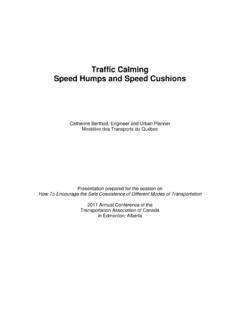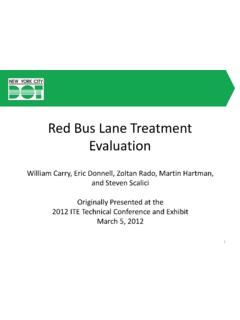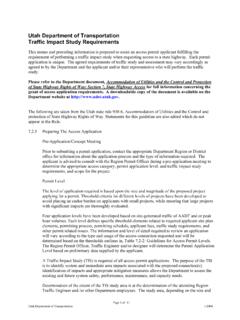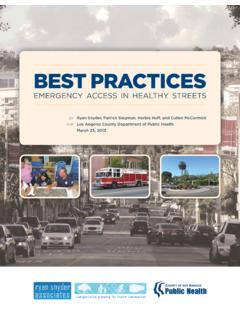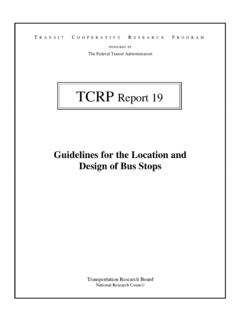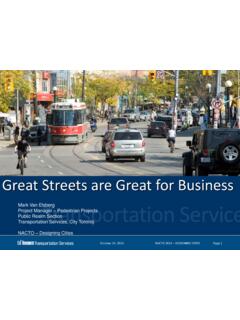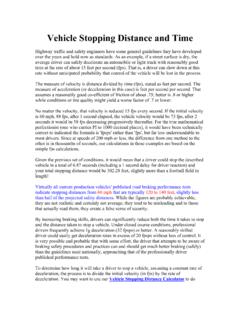Transcription of TRAFFIC SIGNAL TIMING MANUAL - National Association of ...
1 TRAFFIC SIGNAL TIMING MANUAL Publication Number: FHWA-HOP-08-024 Task Order under contract number: DTFH61-98-C-00075 Task Order No. B98C75-009 JUNE 2008 FOREWORD The purpose of the SIGNAL TIMING MANUAL is to provide direction and guidance to managers, supervisors, and practitioners based on sound practice to proactively and comprehensively improve SIGNAL TIMING . The outcome of properly training staff and proactively operating and maintaining TRAFFIC signals is SIGNAL TIMING that reduces congestion and fuel consumption ultimately improving our quality of life and the air we breathe. This MANUAL provides an easy-to-use concise, practical and modular guide on SIGNAL TIMING .
2 The elements of SIGNAL TIMING from policy and funding considerations to TIMING plan development, assessment, and maintenance are covered in the MANUAL . The MANUAL is the culmination of research into practices across North America and serves as a reference for a range of practitioners, from those involved in the day to day management, operation and maintenance of TRAFFIC signals to those that plan, design, operate and maintain these systems. Regina McElroy Director Office of Transportation Management NOTICE This document is disseminated under the sponsorship of the Department of Transportation in the interest of information exchange.
3 The Government assumes no liability for the use of the information contained in this document. This report does not constitute a standard, specification, or regulation. The Government does not endorse products or manufacturers. Trademarks or manufacturers' names appear in this report only because they are considered essential to the objective of the document. Quality Assurance Statement The Federal Highway Administration (FHWA) provides high-quality information to serve Government, industry, and the public in a manner that promotes public understanding. Standards and policies are used to ensure and maximize the quality, objectivity, utility, and integrity of its information.
4 FHWA periodically reviews quality issues and adjusts its programs and processes to ensure continuous quality improvement. 1. Report No. FHWA-HOP-08-024 2. Government Accession No. 3. Recipient's Catalog No. 5. Report Date June 2008 4. Title and Subtitle TRAFFIC SIGNAL TIMING MANUAL 6. Performing Organization Code 7. Author(s) Principal Investigator: Peter Koonce Co-Authors: Lee Rodegerdts, Kevin Lee, Shaun Quayle, Scott Beaird, Cade Braud, Jim Bonneson, Phil Tarnoff, and Tom Urbanik 8. Performing Organization Report No. Project 7257 10. Work Unit No. (TRAIS) 9. Performing Organization Name and Address Kittelson & Associates, Inc. 610 SW Alder Street, Suite 700 Portland, OR 97205 Subconsultants: Texas Transportation Institute, University of Maryland, Purdue University, siemens ITS, Tom Urbanik II, PE 11.
5 Contract or Grant No. Contract No. DTFH61-98-C-00075, Task Order No. B98C75-009 13. Type of Report and Period Covered Final Report March 2006 to June 2008 12. Sponsoring Agency Name and Address Department of Transportation Federal Highway Administration 1200 New Jersey Avenue, SE Washington, DC 20590 14. Sponsoring Agency Code HOP 15. Supplementary Notes Eddie Curtis was the Technical Representative for the Federal Highway Administration. Project focus group members contributed significantly to document organization, content, and exhibits: Michael Kyte, University of Idaho; Ziad Sabra, Sabra, Wang & Associates; James Pond, Monroe County (NY); Jim Poston, Regional Transportation Commission (Reno, NV), Rick Denney, Iteris; Bruce Zvaniga, City of Toronto; Woody Hood, Maryland State Highway Administration; Bill Kloos, City of Portland (OR); Denny Eyler, SRF Consulting; Avery Rhoades, City of Glendale (AZ); Sean Skehan, Los Angeles Department of Transportation (CA); and Susan Langdon, Savant Group.
6 In addition, many staff members of FHWA participated as focus group members and/or provided comments throughout the project, including Ed Fok, John Halkias, Paul Olson, Mike Schauer, Fred Ranck, and Scott Wainwright. 16. Abstract This report serves as a comprehensive guide to TRAFFIC SIGNAL TIMING and documents the tasks completed in Association with its development. The focus of this document is on TRAFFIC SIGNAL control principles, practices, and procedures. It describes the relationship between TRAFFIC SIGNAL TIMING and transportation policy and addresses maintenance and operations of TRAFFIC signals. It represents a synthesis of TRAFFIC SIGNAL TIMING concepts and their application and focuses on the use of detection, related TIMING parameters, and resulting effects to users at the intersection.
7 It discusses advanced topics briefly to raise awareness related to their use and application. 17. Key Words Signalized Intersections, TRAFFIC SIGNAL TIMING , Detectors, Policy Based SIGNAL Control, Maintenance and Operation of TRAFFIC Signals 18. Distribution Statement No Restrictions. This document is available to the public 19. Security Classif. (of this report) Unclassified 20. Security Classif. (of this page) Unclassified 21. No. of Pages 265 22. Price N/A i TABLE OF CONTENTS INTRODUCTION Background .. 1-1 Organization of the Use of the MANUAL .. 1-5 References .. 1-8 SIGNAL TIMING POLICY Policy Development .. 2-1 SIGNAL TIMING Process.
8 2-7 Performance Measures and National Perspective in SIGNAL 2-11 Funding Considerations ..2-13 Examples of Programs ..2-15 References .. 2-17 OPERATIONAL AND SAFETY ANALYSIS 3-1 Characteristics Affecting SIGNAL TIMING .. 3-2 Capacity and Critical Movement Analysis .. 3-5 Intersection-Level Performance Measures and Analysis Techniques .. 3-14 Arterial- and Network-Level Performance Measures and Prediction Techniques .. 3-18 Safety Assessment .. 3-25 SIGNAL 3-27 References .. 3-29 TRAFFIC SIGNAL DESIGN CONCEPTS Overview .. 4-1 Phasing Overview .. 4-3 Left-Turn Display Options .. 4-7 Left-Turn Phase Sequence 4-14 Pedestrian Phasing.
9 4-18 Right-Turn Phasing .. 4-20 Detection Fundamentals .. 4-20 Detection 4-26 References .. 4-31 BASIC SIGNAL TIMING PROCEDURE AND CONTROLLER PARAMETERS Terminology and Key Definitions .. 5-1 Modes of TRAFFIC SIGNAL Operation and Their 5-3 Phase Intervals and Basic Parameters .. 5-5 Actuated TIMING 5-26 Volume-Density 5-31 Detection Configuration and Parameters .. 5-39 Guidelines for Time-Base Controls .. 5-42 References .. 5-43 COORDINATION 6-1 Principles of Coordinated Operation .. 6-2 Coordination 6-8 Time-Space Diagram ..6-16 Transition Logic .. 6-22 Coordination TIMING Plan 6-27 Coordination Complexities .. 6-38 6-49 ii DEVELOPING SIGNAL TIMING PLANS OVERVIEW.
10 7-1 Project Scoping .. 7-4 Data Collection .. 7-10 Model Development ..7-16 Field Implementation and Fine 7-25 Evaluation of 7-27 References .. 7-30 SIGNAL TIMING MAINTENANCE: OPERATIONS AND MONITORING Overview .. 8-1 TRAFFIC SIGNAL 8-2 Day-to-Day Operations .. 8-4 Staffing 8-9 References .. 8-13 ADVANCED SIGNAL TIMING CONCEPTS TRAFFIC SIGNAL Preemption .. 9-1 TRAFFIC SIGNAL Priority ..9-4 TRAFFIC Responsive Adaptive TRAFFIC SIGNAL Planned Special Events, Incident, & Emergency Weather-Related Factors that Influence SIGNAL 9-14 iii LIST OF TABLES Table 2-1 SIGNAL TIMING Strategies, Settings, and Policy Examples ..2-4 Table 2-2 SIGNAL TIMING Process Table 3-1 Steps of the Quick Estimation Method (QEM) (2, with HCM corrections).

